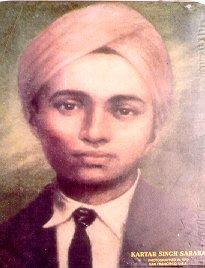Template:AOW224
On April 21,1913, the Indians of California assembled and formed the Ghadar Party (Revolution Party). The aim of the Ghadar Party was to get rid of the slavery of the British by means of an armed struggle and set up a national democratic government. Their slogan was "Put at stake everything for the freedom of the country." On the November 1, 1913, the Ghadar Party started printing a paper named 'Ghadar', which was published in the Punjabi, Hindi, Urdu, Bengali, Gujarati and Pushto languages. Kartar Singh did all the work for that paper.
This paper was sent to Indians living in all countries throughout the world. The purpose of the paper was to unmask the truth about British rule to Indians, impart military training, and explain in details the methods of making and using weapons and explosives. Within a short time, the Ghadar Party became very famous through its organ: 'The Ghadar". It drew Indians from all walks of life.
Kartar Singh Sarabha began his involvement in the Gadar Party in San Francisco in 1912. Sarabha was born in India in the year 1896. After his graduation from high school in 1911, he arrived at the University of California-Berkeley to continue his studies in engineering. In Berkeley, he joined the Gadar party in 1913. Around this time, he also learned how to fly. He returned to India in 1914 to fight for his country's independence. On November 16th, 1915, Sarabha was hanged at the tender age of 19.
"In the early months of World War I, an ambitious attempt to free their country was made by Indians living overseas - particularly in the United States and Canada. Although the overwhelming majority of the Ghadarites were Sikh and the centres of revolutionart activity were the Sikh temples in Canada, the United States, Shanghai, Hong Kong, and Singapore, many of the leaders were of other parties and from different parts of India - Har Dyal, Rash Bihari Bose, Barakatullah, Seth Husain Rahim, Tarak Nath Das and Vishnu Ganesh Pingley...." .....More

